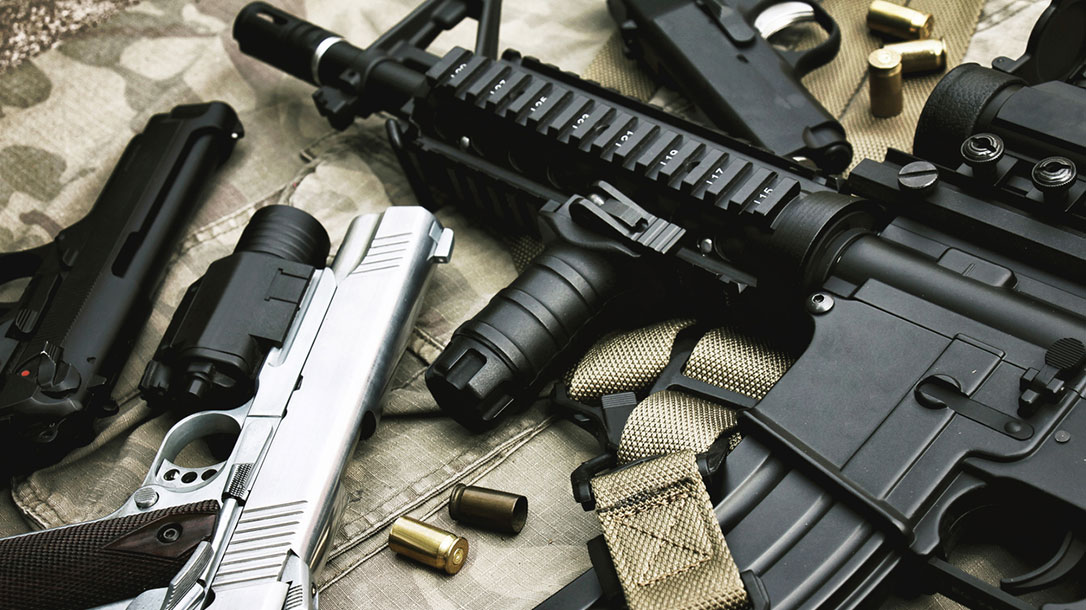As many new and prospective gun owners quickly learn, the wide world of firearms is complex. Trying to understand guns, gun ownership, and shooting can be a daunting task. In this installation, we’ll examine the three primary “types” of firearms you’ll be considering for your first gun. This includes the differences between the types, and what tasks each performs best.
Three Primary “Types” of Firearms
For the sake of this discussion, we’ll keep it simple and break firearms down into three basic categories—rifles, shotguns, and handguns. The vast majority of guns fit into these classifications. Any that might not (black powder, air guns, etc.) aren’t something you need to necessarily worry about at this point in your journey.
Rifles
Rifles are shoulder-fired long guns designed to shoot a single projectile more accurately at longer distances than shotguns or handguns. While there are several “types” of rifle, for brevity’s sake, we’ll look at three—single-shot, bolt-action, and semi-automatic.
Advertisement — Continue Reading Below
Single-Shot Rifles
Single-shot rifles are the simplest design and easiest to use. Most “break open” at the rear of the action so a single cartridge can be inserted. The gun is then locked closed.

After the hammer is cocked, a single “pull” of the trigger will fire a single shot. To fire again, the action must be broken open, the empty casing taken out, another round inserted, the action closed, and the hammer cocked again.
Advertisement — Continue Reading Below
Single-shot rifles are often good first guns because they are so simple and easy to understand. They are often used for hunting medium to big game animals, as well as for plinking and range fun.
Bolt-Action Rifles
Bolt-action rifles have a “bolt” in the action that is pulled back to eject a spent casing. It is then pushed forward to load the next round in the chamber. Subsequent rounds are stored in a magazine—some built-in, some detachable.
Bolt-action rifles are among the most accurate rifles you can buy. Most are used for hunting small, medium and big game animals, target practice or long-range shooting competitions.
Advertisement — Continue Reading Below
Lever-Action Rifles

Lever-action rifles are another common rifle type closely associated with the taming of the West and often seen in Old West movies. They have a lever on the bottom that is used to eject the spent casing and load the next round. Most have a tubular magazine underneath the barrel that holds the rounds to be loaded.
These rifles are often used for hunting, sport shooting, and Cowboy Action competitions. Likewise, some people also use them for home defense.
Advertisement — Continue Reading Below
Semi-Automatic Rifles
Semi-automatic rifles, also called self-loading rifles, are the most complicated type but still not hard to understand. All have a magazine for feeding rounds into the action, with some detachable and some not.
When a shot is fired by pulling the trigger, the rifle tosses the casing out and feeds the next round into the chamber, resetting the firing pin at the same time. Consequently, it is already set to fire again.

Advertisement — Continue Reading Below
Semi-auto rifles are used for everything from hunting to range fun to competition to self-defense. AR-15-style rifles fall into this category, but so do many others.
One thing to note: Unlike some gun-ban proponents would have you believe, semi-autos are not machine guns. Just like single-shot and bolt-action rifles, they fire only one shot with each pull of the trigger.
The difference is that semi-autos eject the spent casing, feed another round into place, and move the firing pin back into the firing position, ready for another shot.
Advertisement — Continue Reading Below
Shotguns
Shotguns are shoulder-fired long guns designed to shoot a number of projectiles—sometimes hundreds—loaded into ammunition called a shotshell. Because of the relatively small “shot” compared to rifle bullets, shotguns are effective at shorter ranges than rifles.
Semi-auto shotguns work basically the same as semi-auto rifles, reloading themselves after each shot. Most, however, don’t have detachable magazines. Likewise, single-shot shotguns work similarly to single-shot rifles.

Advertisement — Continue Reading Below
Pump-action shotguns are made ready to fire again by pumping the fore-end, which is held when shooting by the non-trigger hand. They are simple, dependable, and available from a number of manufacturers.
Double-barrel shotguns, whether side-by-side or over/under, work much the same as single-shot shotguns but have two barrels. Correspondingly, you have two shells that can be fired before reloading.
As with rifles, shotguns are used for everything from bird hunting to competition shooting to range fun to self-defense. When shooting “slugs”—single projectiles for shotguns—many are even used to hunt deer and other game species.
Advertisement — Continue Reading Below
Handguns
Handguns, as the name suggests, aren’t fired from the shoulder but by gripping them with both hands. The most popular type—semi-auto pistols—reload themselves to shoot another round after the first is fired, just like semi-auto rifles. Most have a detachable magazine that fits into the grip, the part held by the hands when shooting.

Revolvers are like semi-autos in the respect that they fire a shot every time the trigger is pulled. However, they differ in the way the next round is loaded.
In a revolver, rounds are loaded in a cylinder that sits in front of the firing pin and behind the barrel. After each shot, the cylinder rotates, or “revolves,” moving the next round into place for firing. After all rounds are fired, the casings are removed, and new rounds are inserted.

Cylinders typically hold five to seven rounds, far fewer than many semi-auto pistols hold. Handguns, both semi-auto pistols, and revolvers, are commonly used for self-defense and concealed carry. They are also often used for plinking, range fun, competition, and even hunting at limited distances.
There you have it, a simplified explanation of the types of firearms on the market. In the next installment of Guns & Shooting 101 we’ll examine the process required for purchasing a gun.























